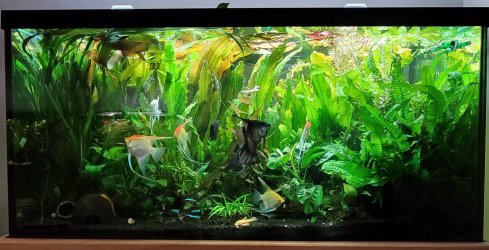By the phrase "my client, the dentist" can we assume you will be regularly maintaining this tank? I ask because the inherent problems that may well arise from a group of angelfish will require intervention by someone like yourself who will recognize the problem(s). If this tank is not to have regular observation and maintenance, angelfish would not be a good idea.
Moving beyond the above...a 150g I assume is 5 feet (150cm) or perhaps six feet (180cm) in length? A group of seven angelfish would be my choice in a 6-foot, or five in a 5-foot. If all are introduced together, and are of the same age/size, this might work out. Having the "dither" fish already settled before introducing the five angelfish (always together, never individually) would be preferable [I'll come back to which dither fish]. If the angelfish develop a basic hierarchy, with some pushing and shoving normal, but nothing beyond that such as fin nipping and serious threats, it may work out. If at some point a pair should form, this tank (5 or 6 foot) will likely prove too small, and either the pair or the other angelfish may have to be removed to save them.
Dither fish. Corydoras are the best choice for substrate level, provided it is a sand substrate. A group of 20-30 minimum in either sized tank (5 or 6 foot). Angelfish will presumably be commercial fish, not wild caught, so temperature around 77-78 F (25-26C) will be OK. [Wild angelfish require discus-temperatures, which would burn out the cories and many other fish too.] For added interest as this will be in a public office (I am assuming), the common Whiptail Catfish (
Rineloricaria parva) as one, two, or three may add some "prehistoric" flavour. Easy to maintain, very peaceful with cories and each other; just make sure it is the common species and not one of the much larger "Royal" species in different genera. There are three different species regularly offered as "Whiptail" Catfish--
Rineloricaria fallax, R. lanceolata and
R. parva--that have slight variations in pattern and the placement of the ventral scutes. It is also possible that some available fish may be hybrids between these three and other species. All have identical requirements in the aquarium. The average lifespan is 5-8 years.
Taxonomic sideline. In the present century this genus has undergone classification changes which are still not fully resolved. Isbrucker et al. (2001) re-established the genus Hemiloricaria [Bleeker, 1862] as distinct, along with two new genera (Leliella and Fonchiiichthys), and on the basis of sexual dimorphism moved several species from Rineloricaria into these three. The latest classification, that of Rodriguez & Reis (2008), partly accepts Isbrucker et al. (2001) phenetic proposition of splitting Rineloricaria and Hemiloricaria; but they propose that Hemiloricaria should comprise a widely-distributed group of species (Amazon and non-Amazon species) whereas Rineloricaria would be restricted to species occurring in the Rio Parana and its tributaries, and the coastal drainages from Uruguay to northeastern Brazil. As of the time of writing, this has not been universally accepted.
The subject species was described by G.A. Boulenger in 1895 and placed in the genus Loricaria. Isbrucker assigned it to Rineloricaria in 1980. Isbrucker et al. (2001) moved it into Hemiloricaria but within a year it was back in Rineloricaria where it is presently deemed valid [according to the Code rules of the International Code of Zoological Nomenclature] whether or not some sites recognize it.
For upper level fish, they need to be quiet swimmers. Rd Phantom are fine, Lemon tetra not. The Phantoms like many of the similar disk-shaped red/mauve coloured
Hyphessobrycon species will remain in the lower half, cruising among plants, chunks of wood, etc. Surface fish are more difficult, but the larger hatchetfish in
Gasteropelecus and
Thoracocharax will (should) work. Avoid the smaller species in
Carnegiella here. Hatchetfish jump, especially if startled (by outside activity, in a dentist's office??) so a well-covered tank is essential. Good idea anyway, to avoid "stuff" getting in.
The Penguin Tetra
Thayeria boehikei is the species most common today, though
T. obliqua may be the name but this is a distinct but similar species, is another surface dweller, and peaceful. Also jumpers, as would apply to any upper fish though.



